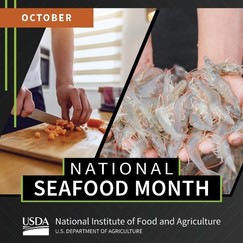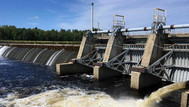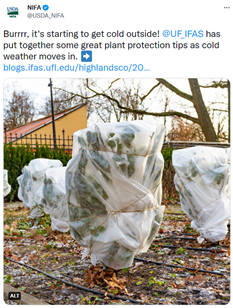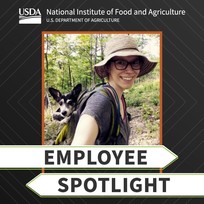|
Having trouble viewing this email? View it as a Web page.

|
|
|
Editor: Lori Tyler Gula, Ph.D. October 26, 2022


Land-grant University Research Benefits Fisheries and Aquaculture
Salmon, shrimp, catfish and other fish provide a significant source of protein, economic activity and recreation, but the nation’s fisheries and aquaculture industries face numerous challenges. Through a multi-state grant funded by NIFA, researchers at 13 Land-grant Universities have been investigating these problems and searching for answers for the last several years.
National Seafood Month NIFA graphic.
|
|
|

NIFA Listening Session for Stakeholder Input to Science Priorities
As part of NIFA’s stakeholder listening initiative, “NIFA Listening Session for Stakeholder Input to Science Priorities,” NIFA is accepting input from stakeholders regarding the agency’s research, Extension and education priorities on Wednesday, Nov. 2 from 8:30 a.m. to 6 p.m. EDT. This initiative supports NIFA’s mission of investing in and advancing agricultural research, Extension and education to solve societal challenges. Register now!
NIFA Listens graphic.
|

Webinar: Biotechnology Risk Assessment Grants RFA Technical Assistance Webinar, October 27 at 4 p.m. EDT Register
Live FAQ Session: Rapid Response to Extreme Weather Events Across Food and Agricultural Systems, December 8 at 3 p.m. EST. More information.
NIFA webinar graphic.
|
In Case You Missed It
Center of Excellence for Meat and Poultry Processing and Food Safety Research and Innovation RFA Technical Assistance Webinar | Watch online.

4-H Spotlight Template
NIFA continues to seek overviews of 4-H Youth Development programs at the institution or statewide level. The September Social Media Toolkit includes a template for a one-page, front/back handout. Sections include an introductory overview, program highlights and recent impacts, with space for photos, a 4-H participant testimonial pullout quote, and appropriate branding and contact information. USDA NIFA’s 4-H staff hopes to develop a bank of such handouts to be used with stakeholders illustrating the value and impact that 4-H programs are having nationwide, while also giving each institution a resource for spotlighting your 4-H initiatives.
4-H graphic logo.
Read More
Impacts of NIFA-funded research and Extension programs on our blogs page.
|

UMaine Researchers Find Inconsistencies in Studies Evaluating Small Hydropower Projects
Hydropower can move beyond enormous, Earth-altering infrastructure. Despite a growing trend of dam removals to preserve and restore ecology and indigenous ways of life, small hydropower projects have the potential to contribute more to a renewable energy future because they can be reliable, flexible and cost-effective, according to a review from the University of Maine.
A hydropower plant, courtesy of the University of Maine.
|

North Dakota Civil Engineer Attributes Career Preparedness to 4-H Experience
Mandan native Kaylin Tomac credits her 15 years of involvement in North Dakota 4-H with preparing her for her career and life after college. Now working as a civil engineer in Bismarck, Tomac graduated from North Dakota State University with a degree in civil engineering in the spring of 2021. She was active in 4-H from the moment she joined as a Cloverbud through her time as an elected state 4-H Ambassador, leading events and promoting 4-H along with other young adult members from across the state.
|

Soybean Virus May Give Plant-Munching Bugs a Boost in Survival
Most viral infections negatively affect an organism’s health, but one plant virus in particular — soybean vein necrosis orthotospovirus, often referred to as SVNV — may actually benefit a type of insect that commonly feeds on soybean plants and can transmit the virus to the plant, causing disease, according to Penn State research.
Asifa Hameed led the study while completing her doctoral degree in entomology at Penn State, courtesy of Asifa Hameed.
|

USDA, USAID announce Global Food Security Research Strategy to Fight Hunger, Build Sustainable Systems
Agriculture Secretary Tom Vilsack and USAID Administrator Samantha Power have released the U.S. government’s Global Food Security Research Strategy, underscoring the U.S. government’s commitment to ending hunger and malnutrition and building medium to long-term sustainable resilient food systems. The new research strategy emphasizes priority objectives and the use of data to help strengthen the impact of U.S. food security assistance and, with America’s leadership, generate sustainable solutions for addressing the root causes of hunger and malnutrition, which are both inextricably linked to entrenched, extreme poverty.
USDA graphic symbol.
Visit USDA for additional USDA news.
|

Census of Agriculture Coming In November
Check your mailbox: USDA will mail the 2022 Census of Agriculture to millions of agriculture producers across the United States and Puerto Rico this fall. Changes to the 2022 questionnaire include new questions about the use of precision agriculture, hemp production, hair sheep and updates to internet access questions.
2022 Census of Agriculture graphic.
|

Burrrr, it's starting to get cold outside! UF/IFAS has put together some great plant protection tips as cold weather moves in.
|

Meet Summer LaRose
Summer serves as a program specialist in NIFA's Institute of Food Production and Sustainability. “I previously worked at the University of Missouri’s Center for Agroforestry, directed the Deaton Scholars Program, and pursued additional wildlife and agriculture research. I was excited for the opportunity at NIFA to stay close to research and to shift my career to impact agriculture and the food system more directly.”
|
|
|
|
NIFA’s mission is to invest in and advance agricultural research, education, and Extension that solves societal challenges. NIFA’s investments in transformative science directly support the long-term prosperity and global preeminence of U.S. agriculture. Keep informed about NIFA, USDA, our Land-grant and non-Land-grant university partners, and stakeholders with the NIFA Update. Read past issues online, sign up for email updates or follow us on Twitter @USDA_NIFA, #NIFAImpacts or LinkedIn @usda-nifa.
If you wish to submit a news item or information, send an email to NIFAUpdate.
USDA is an equal opportunity lender, provider, and employer.
|
|